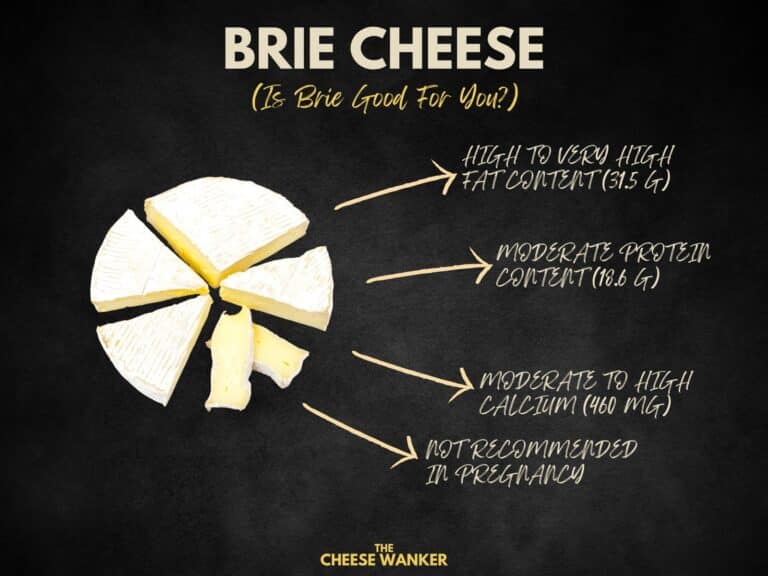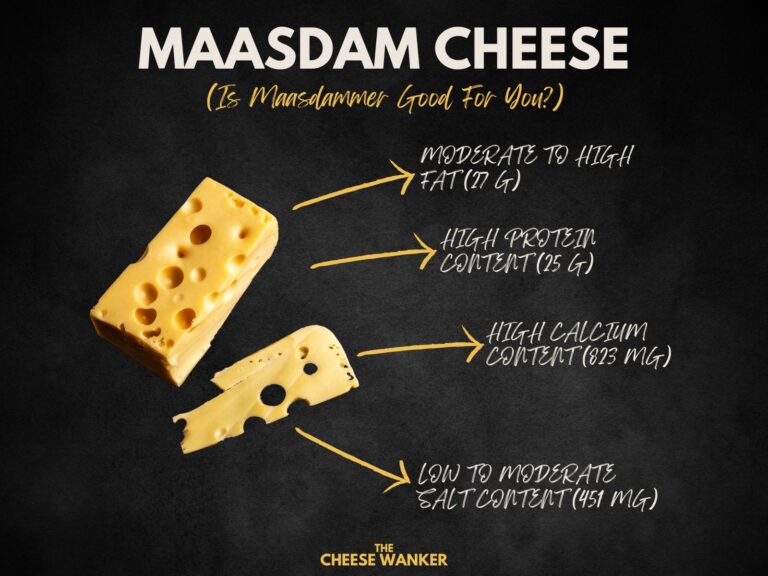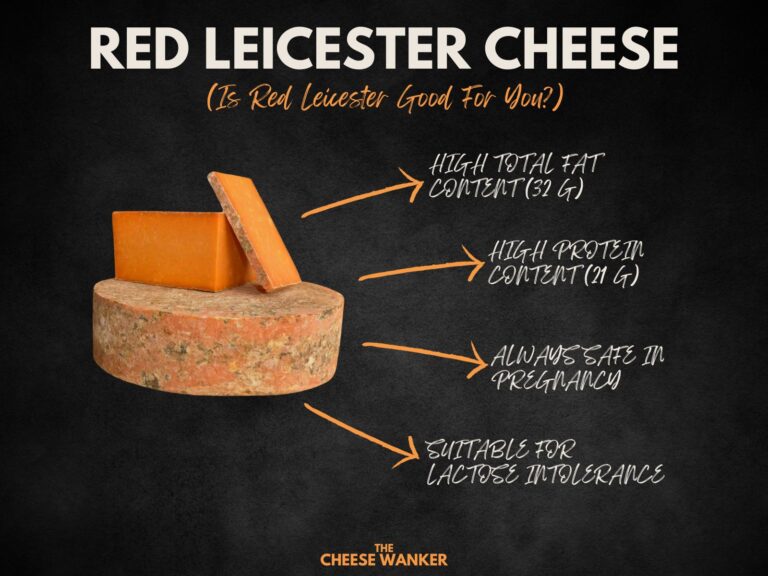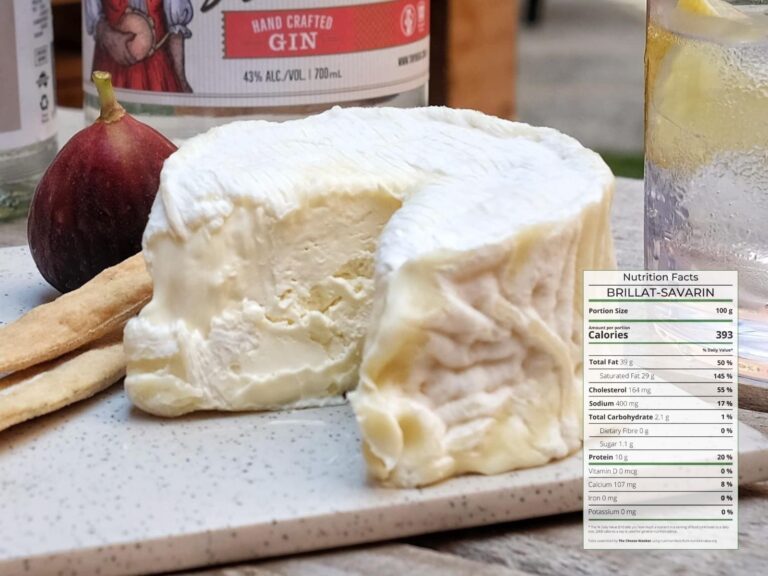Stracciatella cheese, a delectable delicacy enjoyed by cheese enthusiasts, offers a unique blend of flavour and texture. Originating from Italy, this cheese is renowned for its creamy, luscious consistency and rich taste. In this blog post, we delve into the nutrition facts of Stracciatella cheese, exploring its nutrient profile and suitability in pregnancy and lactose intolerance.
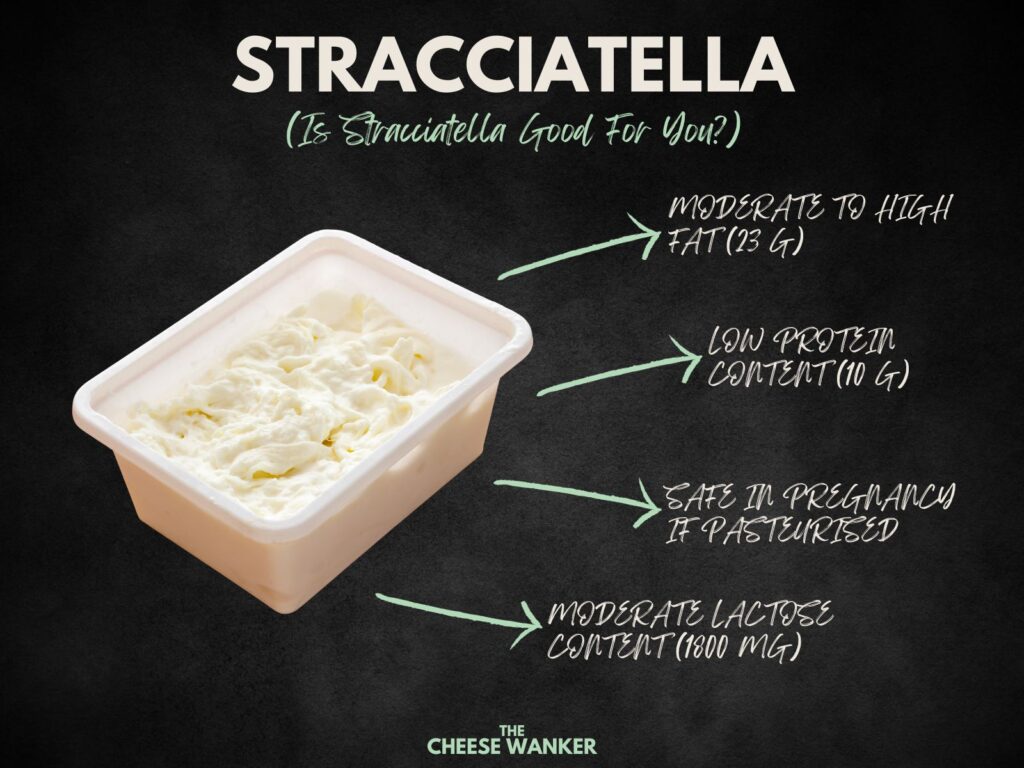
SEE ALSO: Nutrition facts for popular world cheeses in The Cheese Wanker’s index →
What is Stracciatella cheese?
Stracciatella cheese is a soft, creamy cheese originating from Italy. Its name, derived from the Italian word “stracciare“, meaning “to shred” or “to tear”, perfectly captures its unique texture.
Unlike traditional solid cheeses, Stracciatella is a delicate, stringy cheese with a consistency akin to fresh, hand-pulled Mozzarella.
Stracciatella cheese is characterised by its incredibly soft and supple texture. When cut open, it oozes a luscious, creamy consistency, making it ideal for spreading, dipping or drizzling over dishes.
Its flavour profile is mild and slightly sweet, offering a delightful contrast to its smooth texture. The cheese has a fresh aroma, reminiscent of the rich pastures and dairy farms from which it originates, evoking a sense of the Italian countryside.
Nutrition fact sheet
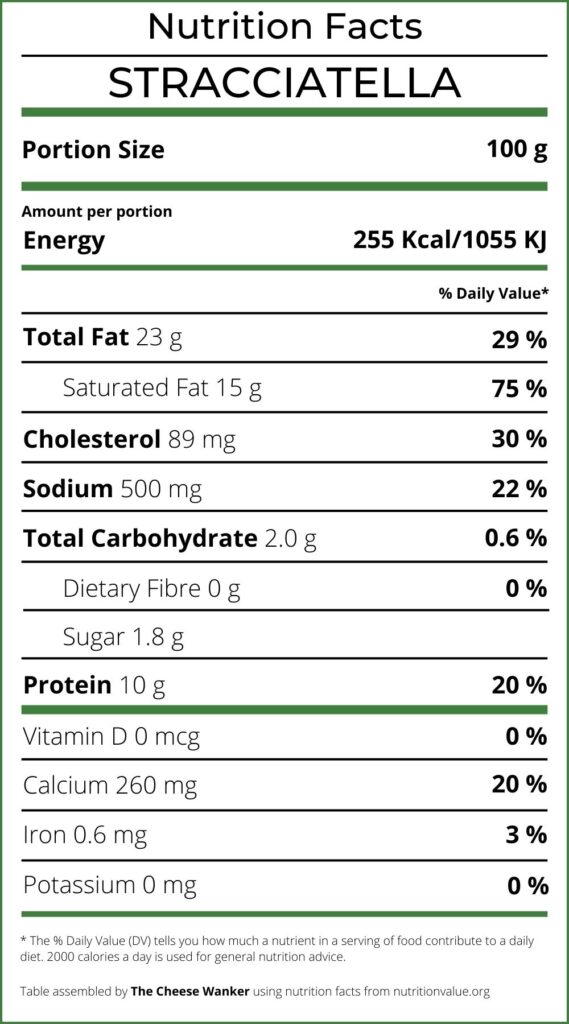
Nutritional review for Stracciatella
Eating healthy plays a pivotal role in maintaining overall well-being and preventing chronic diseases. A balanced and nutritious diet provides our bodies with essential vitamins, minerals, and macronutrients, fuelling optimal physical and cognitive function.
With this in mind, let’s have a look at some of the key nutrition facts for Stracciatella.
Calorie Count
Stracciatella provides 255 calories per 100 grams, a value that might raise eyebrows for some health-conscious individuals. However, it is crucial to recognise that when it comes to calories, quality holds more significance than mere quantity.
The calorie count of Stracciatella cheese reflects not only its energy content but also the richness of its ingredients and the craftsmanship that goes into its production.
Unlike empty calories derived from sugary snacks, the calories in Stracciatella come from natural sources like milk and cream. Therefore, this pasta filata cheese offers essential nutrients alongside its energy content.
Fat Content
Stracciatella boasts a fat content of 23 grams per 100 grams, a value that might raise concerns for those mindful of their dietary fat intake. However, the focus should shift from fearing fats to embracing the significance of nutrient-rich fats in our diet.
While it’s true that fats are energy-dense, providing 9 calories per gram, not all fats are created equal. Stracciatella cheese contains a mix of saturated and unsaturated fats, with a higher proportion of unsaturated fats, including monounsaturated and polyunsaturated fats.
Monounsaturated and polyunsaturated fats are the heart-healthy fats found in foods like olive oil, nuts and fatty fish. These fats play a crucial role in reducing bad cholesterol (LDL) levels and promoting good cholesterol (HDL) levels, thus supporting cardiovascular health.
Additionally, they are rich sources of essential fatty acids, such as omega-3 and omega-6, which are vital for brain function, inflammation regulation, and overall well-being.
You can learn more about the different types of fat in cheese and which cheeses have the lowest fat content here.
Protein Content
Despite having a lower protein content compared to some other cheeses, Stracciatella still stands as a valuable source of this essential nutrient. With 10 grams of protein per 100 grams, Stracciatella cheese offers a delightful culinary experience while contributing to our body’s need for amino acids, the building blocks of life.
Proteins are fundamental biological molecules, serving as the foundation for various bodily functions. They are crucial for the growth, repair and maintenance of tissues, muscles and organs.
Stracciatella cheese, although not a protein powerhouse, contains proteins that are rich in essential amino acids, the ones our bodies cannot produce and must obtain from our diet.
The type of protein found in Stracciatella cheese is particularly noteworthy. It contains both whey and casein proteins, with whey being a high-quality protein known for its rapid absorption and rich amino acid profile.
Want to find out which cheeses have the highest protein content? Click here for our blog post covering cheeses with the highest protein content.
Cholesterol Content
Stracciatella cheese contains 89 milligrams of cholesterol per 100 grams, a fact that might raise concerns for those mindful of their cholesterol intake. However, it is imperative to demystify the misconceptions surrounding dietary cholesterol and appreciate the nuanced role it plays in our overall health.
Cholesterol is a naturally occurring substance in our bodies and is vital for various physiological functions, including the formation of cell membranes and hormones.
And the cholesterol found in food, like Stracciatella cheese, is distinct from the cholesterol circulating in our bloodstream. Current research challenges the notion that dietary cholesterol directly translates into increased blood cholesterol levels for everyone.
Having said that, individual responses to dietary cholesterol vary significantly. While some individuals may experience a slight increase in cholesterol levels after consuming cholesterol-rich foods, others may not be affected at all.
While Stracciatella contains cholesterol, understanding the complex interplay between dietary cholesterol, overall diet and individual physiology is essential. By approaching cholesterol intake with a balanced perspective and making mindful dietary choices, you can enjoy Stracciatella without compromising your overall well-being.
You can learn more about the impact of dietary cholesterol on blood cholesterol levels in our dedicated post here.
Salt Content
Stracciatella, with a salt content of 500 milligrams per 100 grams, delivers a distinctive, savoury taste that enhances its overall flavour profile. While salt plays a vital role in culinary arts, it is essential to comprehend its impact on our health and make informed choices regarding its consumption.
Salt, or sodium chloride, is a mineral that our bodies need in limited quantities for various functions, such as maintaining fluid balance and supporting nerve and muscle function.
However, excessive salt intake is associated with increased blood pressure, a leading risk factor for heart disease and stroke. The balance between sodium and potassium, another essential mineral found in various foods, is crucial for cardiovascular health.
Stracciatella, like many other cheeses, has a moderate to high salt content. It is crucial to be mindful of the salt content, particularly for individuals with hypertension or those at risk of heart-related issues. High sodium intake can lead to fluid retention, putting strain on the heart and blood vessels.
Incorporating Stracciatella cheese into meals can still be part of a balanced diet, provided it is consumed mindfully and in moderation.
You can read more about why salt is important in cheesemaking in our comprehensive post here.
Calcium Content
Containing 260 mg of calcium per 100 g, Stracciatella plays a modest yet valuable role in promoting overall health. While it may not be the primary source of calcium, this essential mineral found in Stracciatella contributes to bone health, providing structural support and strength.
Calcium is crucial during childhood and adolescence for optimal bone development and remains important throughout life, especially for pregnant and lactating women, and older adults who are at higher risk of osteoporosis.
Maintaining an adequate calcium intake supports cardiovascular health and ensures the proper functioning of various bodily systems. Stracciatella, when consumed as part of a balanced diet rich in diverse calcium sources, can contribute to these essential functions, supporting overall well-being.
You can read more about this important mineral and find out which types of cheeses have the highest calcium content in our post here.
Safety in Pregnancy
Stracciatella cheese, when made with pasteurised milk, stands as a safe choice for pregnant individuals. Pasteurisation, a process that involves heating the milk to eliminate harmful bacteria, ensures that the cheese is free from potential pathogens, reducing the risk of foodborne illnesses during pregnancy.
This safety measure provides expectant mothers with the freedom to enjoy Stracciatella cheese without concerns about compromising their health or the health of their unborn child.
Of course, if you’re unsure of what you can eat during pregnancy, you should consult your healthcare professional to get a personalised plan. You can read more about which cheeses you can eat when you’re pregnant by clicking here.
Lactose Intolerance
Stracciatella cheese, naturally abundant in lactose, requires careful consideration for individuals with lactose intolerance.
Individuals with lactose intolerance should approach Stracciatella with awareness and caution, acknowledging their own tolerance levels. Seeking guidance from healthcare professionals or registered dietitians can provide tailored strategies.
Additionally, lactase supplements, which aid in lactose digestion, can be beneficial for individuals wanting to enjoy Stracciatella without discomfort.
Conclusion
In exploring the nuanced world of Stracciatella and its nutrition facts, we’ve unveiled not just the numbers but the intricate science behind this delectable delicacy.
By understanding the quality of calories, appreciating the role of nutrient-rich fats, and acknowledging the significance of minerals like calcium, we can savour Stracciatella cheese with mindfulness and purpose.
In each bite of Stracciatella cheese, there is a wealth of nutrients, history and craftsmanship. Whether you’re relishing its velvety texture in a salad or delighting in its subtle sweetness on a pizza, the knowledge of its nutritional intricacies empowers you to make informed choices.
So, let’s embrace the art of mindful eating, celebrating the taste and nutrition that Stracciatella brings to our tables. As we do so, we not only satisfy our culinary desires but also nourish our bodies, appreciating the harmony between taste and well-being.
References
Overall nutritional content
The nutritional content of cheese in our table comes from the USDA Food Data Central Repository, the Australian Food Composition Database and cheese manufacturers. We realise that there can be variations between different brands and producers. Hence, the numbers we have used are averages.
Fat content
Our fat RDI data comes from Cleveland Clinic’s Healthy Fat Intake resource.
Type of fat in cheese as per Harvard T.H. Chan’s The Nutrition Source.
Protein content
Our protein RDI data comes from Harvard Medical School’s Harvard Health Publishing.
Cholesterol content
Is There a Correlation between Dietary and Blood Cholesterol? Evidence from Epidemiological Data and Clinical Interventions? – Maria Luz Fernandez and Ana Gabriela Murillo
Saturated fat, carbohydrate, and cardiovascular disease – Patty W Siri-Tarino, Qi Sun, Frank B Hu and Ronald M Krauss
Effect of cheese consumption on blood lipids: a systematic review and meta-analysis of randomized controlled trials – Janette de Goede, Johanna M Geleijnse, Eric L Ding, Sabita S Soedamah-Muthu
Safety in pregnancy
All the advice relating to what cheeses you can eat during pregnancy in this article is based on the recommendations by health authorities in Australia, the UK and the USA. If you are unsure about what you can or cannot eat, please consult your doctor.
Australia – FSANZ, United Kingdom – NHS and United Sates of America – FDA
Lactose content
Lactose residual content in PDO cheeses
Detection of lactose in products with low lactose content
The analysis of lactose in milk and cheese products by HPLC
Food Standards ANZ Food Composition Database
Lactose & Galactose content of cheese
